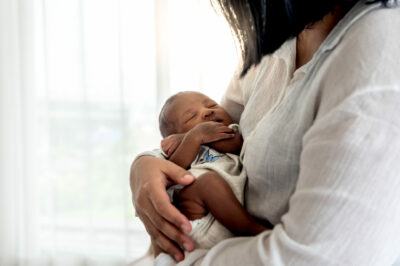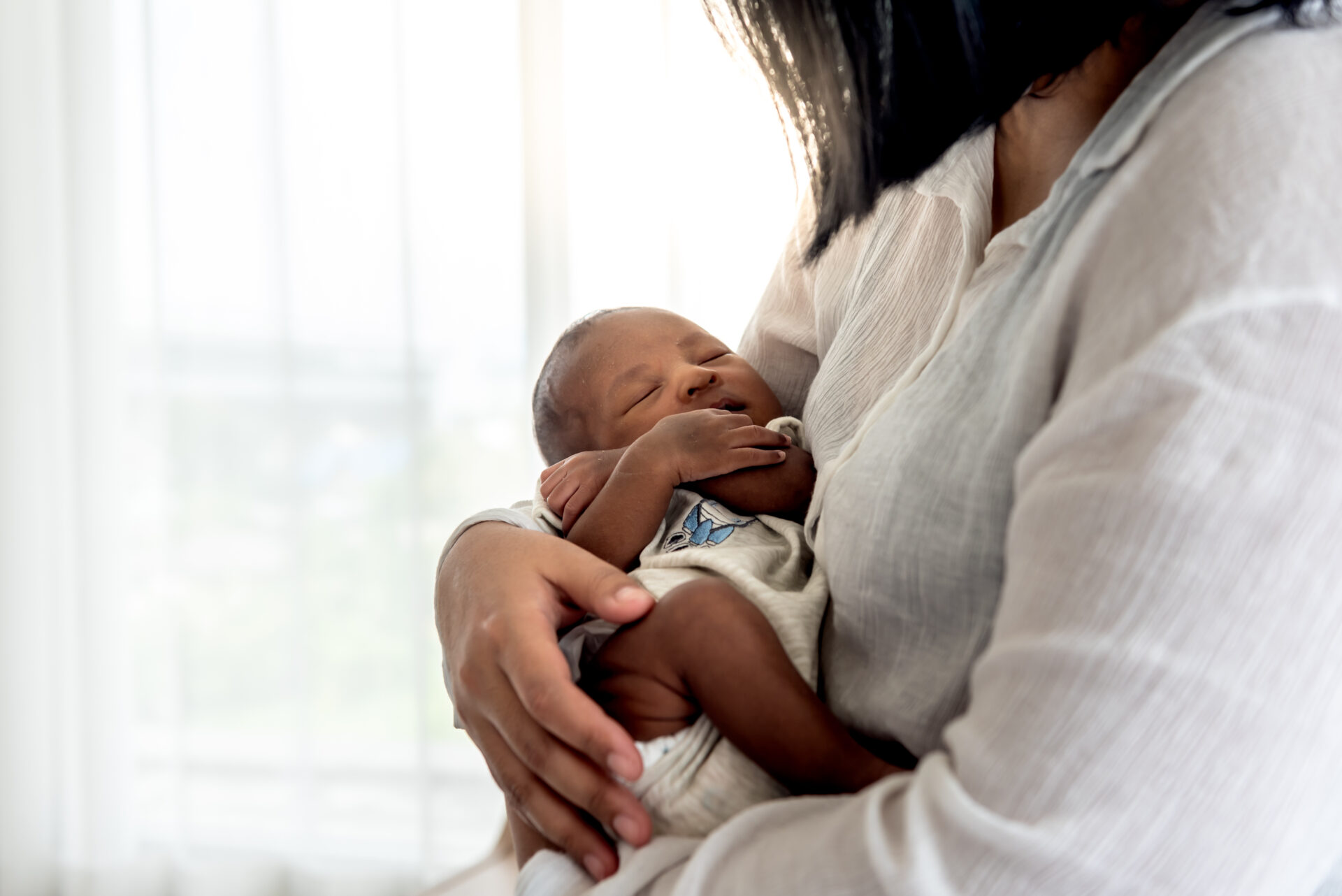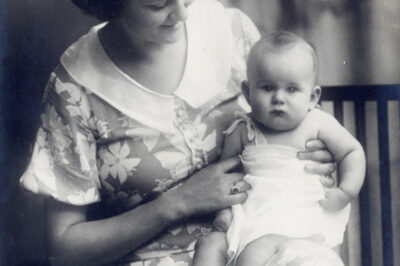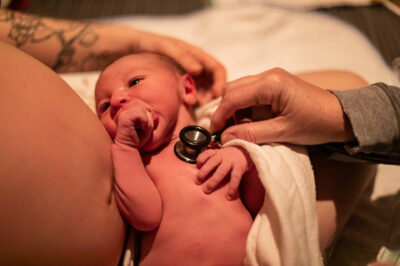The first 48 hours with your newborn can be equally exciting and scary. You have been waiting nine months to meet your little one, and now they are finally here! Within the first 48 hours, your newborn will gradually transition from life in your womb to life outside. If you do not know what to expect, it may feel overwhelming or scary. Hearing your baby cry may be upsetting or even frustrating if you do not know what they need. When they cry, they are communicating with you. They may be letting you know they want to be held, changed, burped or fed. Over time, you will learn to communicate with them as you tune into their subtle cues. This guide will walk you through caring for your newborn in the first 48 hours after your baby is born.
Feeding Baby
Within just minutes after birth, baby’s can begin breastfeeding. All babies benefit from colostrum, the first milk produced, but especially those that are born pre-term.
Your baby will let you know when they are hungry. They communicate feeding cues by sucking on their hands, rooting, or fussing. Prioritize skin to skin contact when feeding as this will help to regulate baby’s temperature. The first 24 hours after birth, attempt to nurse every three hours. Let your baby eat as much as they want. If baby will not wake up to nurse, hand express milk onto a spoon.
Feed at least one spoonful to the baby every three hours. It is normal for your body to produce between 1-4 teaspoons of colostrum per day. Your baby is learning how to suck and swallow so it makes sense that smaller amounts are easier for your baby to manage. Additionally, your baby’s stomach is only about the size of a marble, so what may seem to be a small feeding may be quite large.
Many new mothers feel nervous about their milk supply. It helps to keep in mind that the amount of colostrum you are making is just the right amount for your baby.
How often should I feed my baby?
From 24 to 48 hours after birth, nurse every two-three hours, or at least eight times in a 24-hour period. A feed can last anywhere from 15 to 40 minutes. If you are bottle feeding, 16 to 24 ounces of milk or formula over a 24 hours period is normal. For the first few days after birth, baby will be suckling a lot and will not get much out. Their sucking is stimulating your milk to come in and helps to establish breastfeeding. Until your milk comes in, they will be getting colostrum.
Colostrum is a thick, sticky yellow substance that is filled with antibodies. Colostrum has a laxative effect and will help them pass the meconium and other waste from their system.
Other benefits of colostrum include:
- Provides your baby with the right nutrients for their brain, eyes and heart to grow
- Contains antibodies and white blood cells which helps establish a strong immune system in your newborn
- Helps prevent illness and inflammation by creating a tough coating in your baby’s stomach and intestines
- Aids in the prevention of jaundice and helps to prevent low blood sugar
- Provides the perfect food for your baby that is easy to digest and contains high level of protein, salts, fats and vitamins.
When will my milk come in?
Transitional milk will come in around day three or four postpartum. When your milk starts to come in your newborn should calm a little. Transitional milk will be whitish and more abundant compared to the colostrum. This may be about the time that engorgement occurs as production of milk is increasing.
Baby will lose up to 10% of their birth weight in the first few days. They will gradually gain this weight back over the next 2-3 weeks. If baby does not get to their birth weight in 2-3 weeks, consult with your pediatrician, or a lactation consultant. They may not be getting enough milk. If baby is having a hard time latching, you can hand express or pump milk and feed to baby. Reach out to your midwife or a doula or International Board Certified Lactation Consultant (IBCLC) for help with breastfeeding.
How to Know if Baby is Getting Enough to Eat
You know baby is getting enough milk by the number of dirty and wet diapers. For the first five days of life, they should have one wet diaper for how many days old they are. This will happen until your milk comes in. For example, a one day old should have at least one wet diaper. A two-day-old should have at least two wet diapers. You can stop counting once they are six days old. From six days old forward, they should have about six to eight wet diapers a day.
Stool
Baby’s first stool will be thick, black and sticky. This is normal and is called meconium. It may take a few days for all the meconium to come out. Baby may have passed meconium in utero. After the meconium has cleared you will see a “transitional stool” around 24 hours of life. They can look dark greenish/yellow and may contain mucous. When your milk comes in around day four or five the stool will change again. It will be a liquid orange color that looks seedy. The texture may vary from loose and liquid to more formed and paste-like. After baby is a week old, make sure they have four dirty diapers a day. Formula-fed babies will have soft, well-formed stools. The color can vary from pale yellow to light brown or even brownish green. If you hear baby grunting, grimacing, or straining before popping, this is normal.
Keep the diaper area clean and dry. Cleanse skin with a warm cloth and mild soap. If a rash appears, expose the area to air and/or use a diaper rash preparation. A swollen scrotum on your baby boy or swollen labia on your baby girl is normal in the first few days. There is an increase in hormones circulating in their body. It is temporary and will resolve naturally on its own. Psudeomenstruation may occur in baby girls. She might bleed from her vagina because of all the hormones. Again, this is normal and will resolve on its own.
When to Call the Pediatrician
Constipation is rare in breastfeed babies. If your newborn is having one dirty diaper or less a day, they may not be getting enough breast milk. Call your pediatrician and schedule to meet with an IBCLC.
Circumcision care
If you choose to circumcise your baby, treat the area like a wound. Wash the penis as it heals. Once the initial dressing falls off, you can place a gauze with some petroleum jelly on so it doesn’t stick to the diaper. Otherwise, it is fine to keep the tip of the penis uncovered. If stool gets on the penis, gently wipe it away with warm soapy water. It will take about seven to ten days for the penis to heal.
When to Call the Pediatrician
- Blood in their diaper larger than a quarter.
- Redness and swelling around the penis that gets worse.
- Any signs of infection such as: pus, fever, foul smelling odor or drainage, warmth around the tip of the penis
- No wet diaper or urination within 8 hours after circumcision.
Caring for the uncircumcised penis is no different from cleaning or caring for the rest of the body. Clean with soap and water. During infancy, the foreskin is connected to the head of the penis. Separation will occur on its own months to years later. Do not force or encourage the foreskin to detach. Once separation occurs, the foreskin will retract naturally. You can clean this area the way you would the rest of the body.
Skin
Your baby might come out with a cone head or puffy eyes. Both will resolve themselves on their own in a few days. Often they occur from getting squeezed through the vaginal canal or a long labor.
Sometimes baby’s skin might turn a yellowish color, this is called jaundice. Jaundice occurs around day two to six of life. Most of the time, jaundice goes away on its own. Breastfeeding baby in a window or outside in the sun can help prevent jaundice from occurring or can minimize the time that baby is jaundice.
To check for jaundice, take your finger and gently press on to baby’s face – if the skin appears yellowish your baby may be developing jaundice. The yellow color presents first in the face and then travels to the rest of the body. If baby is completely jaundice, the whites of their eyes, palms and soles of feet will be yellow.
When to Call the Pediatrician
- Baby has visible yellow discoloration of skin or eyes. Palms of hands and soles of feet are yellow.
- Dark color urine
- Pale colored stool
- Baby is extremely sleepy and will not stay awake or feed.
Cord Care
The umbilical cord stump is a little reminder that your baby was just inside, attached to your womb. Once the cord is cut, there will be a small part still attached to the navel. Over the next few days and weeks, the cord will slowly die. Then it will eventually fall off. The entire process should take about 2-3 weeks. You may see some drainage, crust or dried blood as it dries. This is normal. There is no need for alarm. Let the stump fall off naturally. Do not pick at it or encourage it. If it gets caught, or pulled too soon, it could bleed continuously. If this happens, call the pediatrician immediately.
To care for the area, keep it clean and dry. Use a wet washcloth to wipe it down, then pat it dry. Air the stump out often to expose it to air and dry it out. Wait to bathe the baby until after the stump falls off. Sponge baths are fine until the stump is gone. Avoid putting pressure on the stump. Dress and diaper baby with care. Choose clothes that are loose fitting. When diapering, fold down the front part of the diaper to avoid putting pressure on the stump.
When to Call the Pediatrician
It is very rare that the umbilical stump gets infected. If you notice any signs of infection at the stump site, notify your pediatrician. Signs of infection include:
- reddened skin
- swollen at the base of the stump
- excessive bleeding
- oozing pus or discharge
- fever
- foul smell from the stump
- baby cries when you touch the cord or the area around it
Activity
In the early days, baby will sleep a lot! They will only wake up every two to four hours to feed. Typically newborns need 14-17 hours of sleep in a 24 hour time period. Periods of wakefulness will increase as the baby grows.
Bathing
Wait for at least 24 hours after birth to give baby their first sponge bath. Waiting until they are 24 hours old will help them maintain their body temperature. To help keep baby warm, turn the temperature up in the room beforehand. Try to avoid bathing right after feeding or when baby is tired. It is best to do it when baby is awake and alert. Use warm water for the sponge bath. Once the cord falls off, you may bathe baby in a sink or tub with warm water. You can use a mild soap if you wish. Wash the diaper area last. Do not use powder or lotion unless directed by your care provider. Do not cut the fingernails. Instead use an emery board or put mittens or socks on baby’s fists so they do not scratch themselves.
Safety
- Never leave the baby unattended.
- Never leave the baby on a surface where rolling off may occur.
- Always use a car seat. (Follow the manufacturer’s guidelines on how to install it or go to a certified car seat inspection station)
- Make sure that anyone who holds the baby is healthy and has just washed their hands.
Sudden Infant Death Syndrome also known as SIDS is any sudden death in a seemingly healthy baby under one. SIDS is diagnosed by a process of elimination. Because of this, the etiology and causes of SIDS are widely unknown. Infants who pass from SIDS may have an underlying condition, even though they seem healthy. The risk of SIDS is small. Risk factors to developing SIDS include low birth weight, maternal smoking, preterm infant, over bundling of baby, soft bedding, and face covering or blankets in the crib. You may look into the chemicals used in baby’s mattress. Placing a baby on an organic, chemical free mattress may be safest.
The following are a list of tips to prevent SIDS from occurring.
SIDS Prevention
- Place baby on “back to sleep”
- Do not smoke or allow others to smoke around baby
- Breastfeed if at all possible
- Keep the baby in a crib free of stuffed animals, bumpers, or pillows
- Do not overdress, baby. Avoid putting hats on for sleep and dress them in light clothing.
What to Expect After Delivery
After you deliver, medical providers will want to assess your newborn for any abnormalities and document what they find. If baby is healthy and crying when they come out, the assessments can wait. Request that your baby is brought to your chest. This will be comforting to you and your newborn. Being skin to skin with you will regulate their body temperature. Often babies who are immediately placed on their mother’s stomach after birth will instinctively crawl up towards the breast. They are looking for the nipple and want to feed. They will not get much out as your milk is not in, but it will stimulate the production of milk, oxytocin and help form a secure attachment for breastfeeding.
If you deliver in a hospital, the general assessments medical providers take include a height, weight, head circumference, hearing screen, and a pulse oximeter test. A nurse will check your newborn’s vital signs (respiratory rate, heart rate, pulse ox and temperature) every four hours. They will monitor any input (breast milk or formula) and output (urine or stools) of your infant. You have the option to give Vitamin K injection and erythromycin ophthalmic ointment to your baby. Medical providers will also offer you a genetic blood screening. This screening tests baby for a variety of different genetic disorders. Blood is drawn from their heal and then sent to the state lab.
If you deliver at home or at a birth center, plan to visit your pediatrician 24-72 hours after delivery so that baby can be assessed. If you have any concerns before the pediatrician appointment, call your Midwife or doctor. You can monitor your newborn’s respiratory rate and temperature every four hours until you see your pediatrician. A normal respiratory rate for a calm, sleeping newborn is 30-60 breaths per minute. A normal temperature taken from the armpit is 97.8F- 99.5F If there is concern about the baby’s health or if you feel that a more accurate temperature is needed you can take a rectal temperature. To take a rectal temperature coat the end of the thermometer with lubricant. Hold baby firmly so they won’t wiggle. Then insert the thermometer about one inch into the rectum. A normal rectal temperature range is 97.9F-100.3F. It is not recommended or necessary to take a rectal temperature on your newborn every four hours. You can also monitor their input and output to make sure they are hydrated and getting enough.
When to call the Midwife or Pediatrician
A temperature that is less than 97.9 F or more than 100.3F call the Pediatrician or Midwife.
Your newborn baby is fragile, vulnerable and completely dependent on you. However, they are resilient and much smarter than we even know. Just like you grew your child inside of you without knowing what you were doing, you know what is best for your newborn. No one knows your infant better than you. You are the best, most competent parents for them.
Key Takeaways
- The first 48 hours of caring for a newborn can be overwhelming but are crucial for bonding.
- Newborns should feed every two to three hours, starting with colostrum, which is vital for their health.
- Monitor your baby’s wet and dirty diapers to ensure they are getting enough to eat during this time.
- Keep the umbilical cord stump clean and dry, and consult a pediatrician if there are any concerns.
- Be aware of signs like jaundice or feeding issues, and contact a healthcare provider if needed.



 Tips for Managing Stress During Pregnancy
Tips for Managing Stress During Pregnancy





Leave a Reply